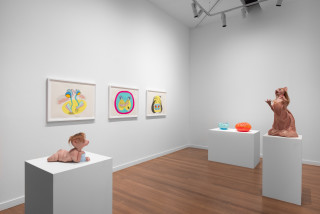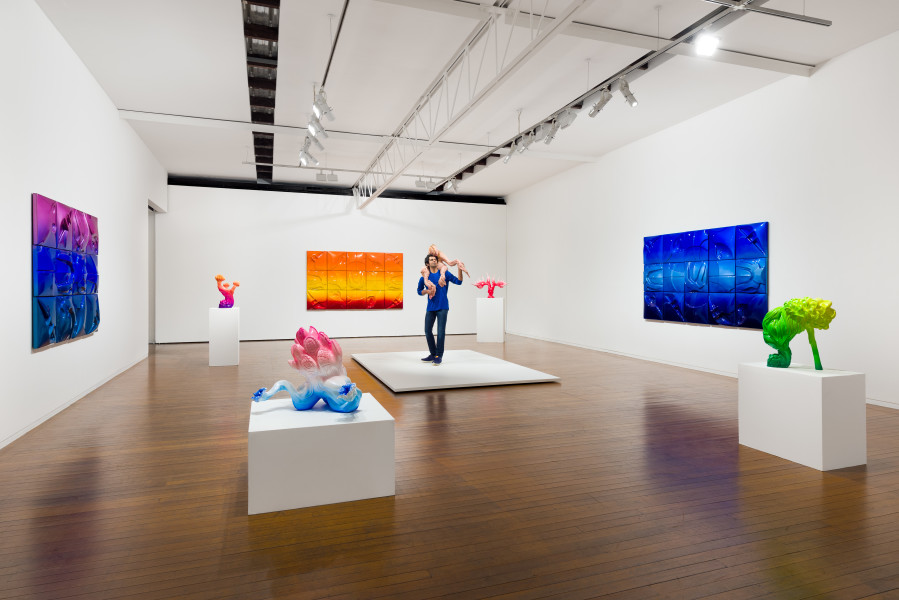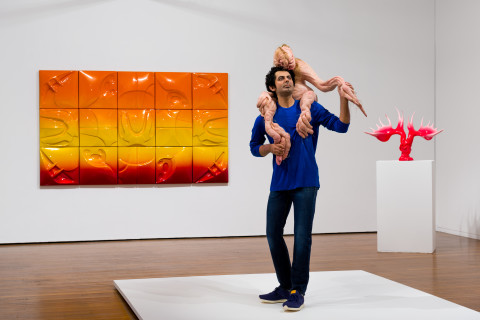The more I learn of the beauty and intricacy of this system the more I am overwhelmed both by how amazing it is and by how little we are doing to protect it. However, when I hear about people getting together to stand up for a gum tree in Bulleen, I think that maybe there is room for hope.
—Patricia Piccinini
Exhibition Dates: 20 August – 19 September 2020
This exhibition brings together a number of new works that looks at ideas about nature and the contemporary world in order to ask questions about how people might reimagine our relationship with nature, and what exactly ‘nature’ might be. This is a long-term interest of mine, and one that I have come at from many angles over the years. In this exhibition my main focus is plants. I am fascinated by their vegetal resilience, by their strangeness but also by the many things we have in common. In plants we see the same basic approach to sexual reproduction that we have, and we also see a way of living that involves intricate networks of communication and interaction with the organisms around us. Plant intelligence is not something that we would understand or be able to interact with, but it is something we are starting to recognise.
At the centre of the exhibition is Sapling (2020). This is a work that comes out of a confluence of a few things I have heard and been thinking about over the last year or so. It started when my sister became part of a group, led by local Wurundjeri people, to save a tree that was growing in the forecourt of a petrol station in suburban Melbourne. It is the most unlikely spot to find a tree, particularly a tree that is over 300 years old. This is a tree that was already old before white people even came to Australia. This is a tree that has survived all of the upheaval, change and destruction that followed the colonisation of this land. This tree is still surviving in what has become an incredibly inhospitable location. Now, some people want to kill it to make way for a new highway, and other people want to save it, and a still great number of people don’t even know about it, or care.
To me, this tree is the most perfect manifestation of the sort of tensions between the natural and artificial that is at the core of all of my work. It is nature’s installation, nature’s art work, yet it stands within the most artificial landscape imaginable. It has this extraordinary value and this irreplaceable history, and while some people recognise that and are willing to stand up for it, to others it is nothing more than an impediment to progress. All the while the tree sits there, quietly processing a small portion of the pollution that surrounds it into the oxygen we require to live.
Around the time my sister told me about this tree, I became aware of the work of Robin Wall Kimmerer. She is an American Potawatomi woman, botanist and pioneer of the integration of traditional ecological knowledge with western academic scholarship. Kimmerer has this very interesting understanding of plants and this opened up my eyes to the sorts of relationships that we can have with them. I had heard of the idea of giving personhood to plants in order to help save our forests, especially our old growth forests but her approach gave this sense of them being much more alive and with agency and their own relationships. This idea of ‘personhood’ is quite an interesting one. It is certainly not perfect, given that it still prioritises the ‘person’ part, but it has an established history that makes it useful. We grant personhood to companies, which gives these artificial organisations certain legal rights and protections. If we give this status to trees it would help to establish their rights under our existing legal system, and hopefully give them greater protection. Ironically, this is still mostly for our benefit: We cannot survive without plants but they will thrive without us.
This led me to think about a work that might imagine a relationship between the person and a plant, but a plant represented with the sort of agency and sentience that allows us to see its connection to us, rather than its difference. I wanted to create a kind of plant chimera, to make it more clear that this relationship could be really intimate and familial. I wanted to see the person as a nurturer of the plants rather than just seeing trees and plants as resources to be exploited for our benefit. I wanted to show the life in the plant creature. To me, even though there is an element of strangeness that comes from rendering them as this fleshy hybrid, there is also a sense of its sentience and vitality.
The pose is drawn from an experience I had meeting a woman named Margit who fosters orphaned tree kangaroos in North Queensland. In Margit I found a woman who has a deep and sincere inter-species relationship with a wild animal, who she supported without any desire to domesticate. The tree kangaroo would ride around on Margit’s shoulder, almost like a second head, and I was struck by the intimacy of this situation. I visited her house with Dennis Daniel, who has worked with me in the studio for more than twenty years. Dennis had children around about the same time I did, and I thought it would be interesting to present a paternal image for a change. So Dennis agreed to step out from behind the scenes and model for the work.
Sapling is ultimately a very positive work. It presents a deeply hybrid relationship between a person and a plant/animal chimera whose personhood is self-evident despite their difference. The positivity in the work derives from our ability, or perhaps willingness, to imagine the commonality and embrace the difference of the two figures. It is not a representation of how the world is, but it is a somewhat mythological depiction of how we could connect with the organisms that surround and support us.
Alongside Sapling are a series of smaller sculptures that I call Shoeforms (2019). These works come out of the strand of my work that draws from automotive culture and aesthetics to examine the ‘naturalisation’ of technology. This is the process whereby technology becomes so embedded in our life that it becomes fundamental to our very nature. These works begin with that notion but uses it to celebrate the very action of life, removed from the artificial-natural dichotomy.
I am trying to find a way to represent fertility in this most expanded sense. Life, abundance, diversity, fecundity, reproduction, parenthood: all these ideas animate the world that I am trying to make, just as they animate the world around us. I am especially interested in looking for ways to represent this that don’t fall into the traditional clichés and associations that belittle the mother or reduce sensuality to obscenity. How can we talk about sex without resorting to porn? In much of my work I am looking for different ways to celebrate life and a different kind of beauty. These works suggest all these ideas in their surreal blending of elements that never quite settle into one category.
The Shoeforms are shifting amorphous forms, sliding between plant, machine, animal, object and organism. Their glossy surfaces are as unselfconsciously beautiful as flowers, and their forms suggest constant motion. It is as if we’ve caught them in a moment, held in a form that they will move through but never return to.
The third part of the exhibition is a suite of drawings that returns to another of my fascinations: birds and hair. Hair represents another ‘in between’ form, living but also somehow not alive. It grows but it has no feeling. It also symbolises sensuality, and in these drawings often evokes bodily forms. The birds, all native to this land, are another element in this amazing network of plants, animals and micro-organisms that supports the world. Some of these birds are pollinators, agents for the sexual reproduction of plants, while others spread seeds. Even their droppings are the perfect fertiliser, returning to the plants the nitrogen they themselves cannot produce.
The more I learn of the beauty and intricacy of this system the more I am overwhelmed both by how amazing it is and by how little we are doing to protect it. However, when I hear about people getting together to stand up for a gum tree in Bulleen, I think that maybe there is room for hope.
—Patricia Piccinini
 Group Show, The First 40 Years
Group Show, The First 40 Years
Roslyn Oxley9 Gallery, 2024
 Patricia Piccinini The way they connect without seeing
Patricia Piccinini The way they connect without seeing
Roslyn Oxley9 Gallery, 2023-24
 Patricia Piccinini The Skywhale Suite
Patricia Piccinini The Skywhale Suite
Online Gallery, 2021
 Patricia Piccinini The Gardener’s Eye
Patricia Piccinini The Gardener’s Eye
Roslyn Oxley9 Gallery, 2020
 Group Show, THE PUBLIC BODY 0.3
Group Show, THE PUBLIC BODY 0.3
Artspace, Sydney, 2018
 Patricia Piccinini Curious Affection
Patricia Piccinini Curious Affection
Queensland Art Gallery | Gallery of Modern Art, Brisbane, 2018
 Group Show, The shape of things to come
Group Show, The shape of things to come
Buxton Contemporary, 2018
 Divided Worlds
Divided Worlds
Adelaide Biennial of Australian Art, 2018
 Patricia Piccinini The Struggle and the Dawn
Patricia Piccinini The Struggle and the Dawn
Roslyn Oxley9 Gallery, 2017
 Group Show, Soft Core
Group Show, Soft Core
Casula Powerhouse Arts Centre, 2016
 Group Show, New Romance: Art and the Posthuman
Group Show, New Romance: Art and the Posthuman
Museum of Contemporary Art Australia, Sydney, 2016
 Patricia Piccinini ComCiência
Patricia Piccinini ComCiência
Centro Cultural Banco do Brazil, Sao Paulo, 2015-16
 Patricia Piccinini The Shadows Calling
Patricia Piccinini The Shadows Calling
Dark Mofo, Hobart, 2015
 Patricia Piccinini The Skywhale
Patricia Piccinini The Skywhale
National Gallery of Australia, Canberra, 2013
 Patricia Piccinini I have spread my dreams under your feet
Patricia Piccinini I have spread my dreams under your feet
Roslyn Oxley9 Gallery, 2013
 Patricia Piccinini Inflorescence
Patricia Piccinini Inflorescence
Mirvac Commission, 2012-15
 Patricia Piccinini Once upon a time
Patricia Piccinini Once upon a time
Art Gallery of South Australia, Adelaide, 2011
 Patricia Piccinini Beyond our kin
Patricia Piccinini Beyond our kin
Roslyn Oxley9 Gallery, 2010
 Patricia Piccinini Evolution
Patricia Piccinini Evolution
Tasmanian Museum and Art Gallery, Hobart, 2009
 Patricia Piccinini Related Individuals
Patricia Piccinini Related Individuals
Roslyn Oxley9 Gallery, 2008
 Patricia Piccinini Recent Drawings
Patricia Piccinini Recent Drawings
Roslyn Oxley9 Gallery, 2006
 Patricia Piccinini Unbreaking Eggs
Patricia Piccinini Unbreaking Eggs
Roslyn Oxley9 Gallery, 2005
 Group Show
Group Show
Roslyn Oxley9 Gallery, 2005
 Patricia Piccinini Precautionary Tales
Patricia Piccinini Precautionary Tales
Roslyn Oxley9 Gallery, 2003
 Patricia Piccinini We Are Family
Patricia Piccinini We Are Family
50th Venice Biennale, 2003
 Patricia Piccinini Autoerotic
Patricia Piccinini Autoerotic
Roslyn Oxley9 Gallery, 2002
 Group Show, The First 20 Years
Group Show, The First 20 Years
Roslyn Oxley9 Gallery, 2002
 Group Show, All Stars
Group Show, All Stars
Roslyn Oxley9 Gallery, 2000
 Patricia Piccinini Swell
Patricia Piccinini Swell
Artspace, Sydney, 2000
 Patricia Piccinini Desert Riders
Patricia Piccinini Desert Riders
Roslyn Oxley9 Gallery, 2000
























